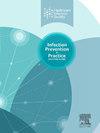Investigation of relative humidity distribution and its impact on disinfection using a combination of robotic fogger and hydrogen peroxide
IF 1.9
Q3 INFECTIOUS DISEASES
引用次数: 0
Abstract
Background
Relative humidity is a key factor in the disinfection process.
Aim
To examine the distribution of relative humidity, and the time required to reach its mean value in the target area when using a robotic fogger with 7.4% hydrogen peroxide.
Methods
The study evaluated the device in both stationary and mobile operation modes. In each mode, relative humidity sensors, along with chemical, biological, and enzyme indicators, were employed to assess the disinfection's effectiveness and consistency.
Results
The device dispersed disinfectant at a rate of 30 mL/min over 45 min in both modes. A shorter time to reach the mean relative humidity is desirable for effective disinfection. It was observed that the mobile mode reached the mean relative humidity 50% faster, maintained this level for an additional 30 min, and achieved an 11% higher relative humidity compared to the stationary mode.
Conclusion
These advancements could assist pharmaceutical manufacturing and healthcare facilities in minimizing downtime during periodic disinfection.
相对湿度分布及其对双氧水联合喷雾消毒效果的影响
背景相对湿度是消毒过程中的关键因素。目的研究在使用7.4%过氧化氢的自动雾化器时,相对湿度在目标区域的分布,以及达到其平均值所需的时间。方法对该装置在固定和移动两种操作模式下进行评价。在每种模式下,采用相对湿度传感器以及化学、生物和酶指标来评估消毒的有效性和一致性。结果两种消毒方式均以30 mL/min的速度在45 min内分散消毒。较短的时间达到平均相对湿度是有效消毒所需的。观察到,与静止模式相比,移动模式达到平均相对湿度的速度快50%,保持这一水平的时间增加了30分钟,相对湿度提高了11%。结论这些技术进步可以帮助制药企业和医疗机构减少定期消毒的停机时间。
本文章由计算机程序翻译,如有差异,请以英文原文为准。
求助全文
约1分钟内获得全文
求助全文
来源期刊

Infection Prevention in Practice
Medicine-Public Health, Environmental and Occupational Health
CiteScore
4.80
自引率
0.00%
发文量
58
审稿时长
61 days
 求助内容:
求助内容: 应助结果提醒方式:
应助结果提醒方式:


